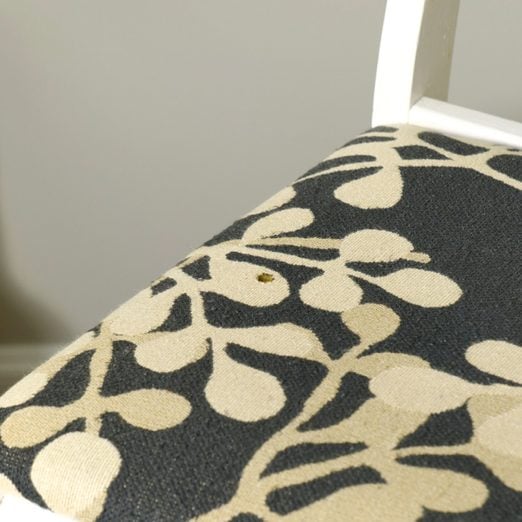Upholstery Repair: How to Fix a Hole
Updated: Apr. 10, 2024
This simple upholstery repair can have your furniture looking like new in no time.
1 hour
Beginner
Less than $25
Introduction
We will show you how to fix a hole in upholstery, a straightforward upholstery repair that even novice DIYers can complete.
Tools Required
- Curved or straight upholstery needle
- Iron
- Phillips or flat-head screwdrivers
- Scissors
- Stapler w/staples
- Toothpick
Materials Required
- Fabric backing(iron on or scrap piece of fabric)
- Fabric for repair
- Flexible fabric adhesive
Yes, there is a way to repair holes in upholstery. Whether it is a small tear or a burn hole from a fireplace ember, you can fix it. You’ll just need patience and attention to detail.
It can be very frustrating looking down at a small hole in an upholstered piece of old furniture, knowing you should be able to repair it but not having a clue where to begin. As with most things requiring a repair, the answers to fixing upholstery can seem like ancient secrets hidden behind a cloud of long-lost wisdom. I am here to share some of those upholstery secrets, put the wisdom in your hands and help you repair your favorite piece of furniture instead of tossing it out over a silly little hole.
Project step-by-step (7)
Prep
In order to repair the hole, you must disassemble the seat and access the back of the fabric and hole — almost like you are about to reupholster the chair completely. If disassembling the piece of furniture is too challenging, you may be able to repair it from the front.
Neatly trim the hole, clearing away any frayed strands or burn marks with a sharp pair of scissors.
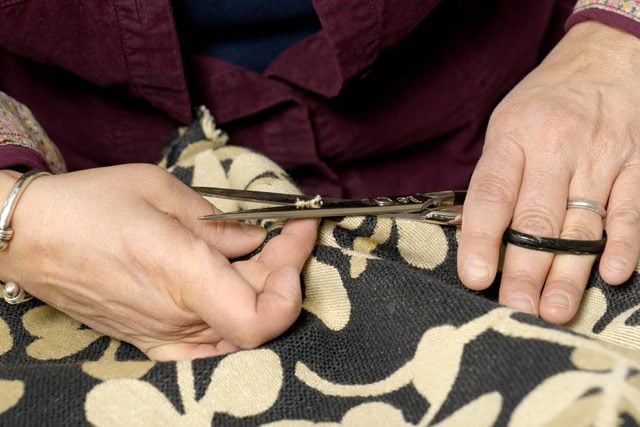
Cut fabric upholstery patch and backing
Cut out a piece of fabric about 1/4 inch larger in each direction than the hole you’re repairing, ideally using the same fabric material. Look at the orientation of the weave and try to orient the patch in the same direction. If there is a pattern or image on your fabric, try to cut the exact orientation of the print. This will work best if you have the exact same material.
If you don’t have the same material, look on the non-visible parts of your piece of furniture and determine if you can cut a small piece from a section where it won’t be noticed. It may be possible to cut away a small amount from the underside of the piece of furniture. Look on a seam or hem where it will not show.
If you still can’t find enough fabric to cut a patch, then you will have to use a complementary piece of fabric. If this is the case, embrace the repair and make it a statement or design choice that can stand out with pride.
Cut a slightly larger piece of fabric backing than the fabric patch. Again, about 1/4 inch larger in each direction to allow for enough room to lay down a bead of glue along the edge. For fabric backing, use fabric that already has iron adhesive — instead of breaking out the glue, you’ll just have to iron it in place.
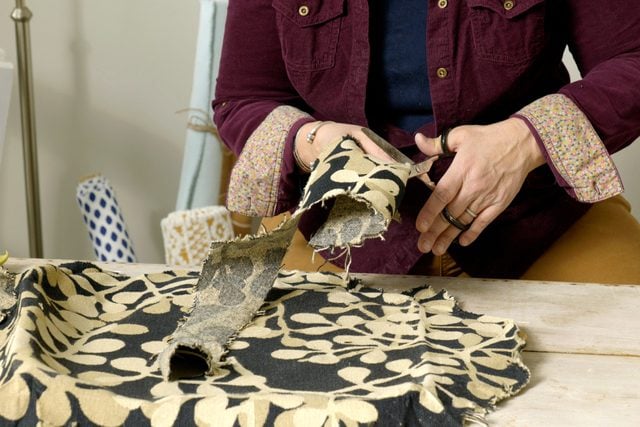
Glue patch into place
From the back side of the fabric, glue on the fabric patch. This is the fabric that will be seen when viewing the patched hole, so be sure to orient the weave in the same direction as the rest of the upholstery. Use flexible fabric adhesive to secure in place. Keep any glue from seeping into the hole.
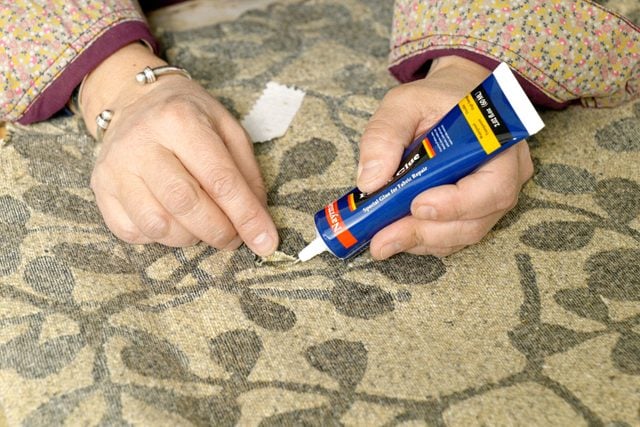
Glue backing into place
Once the fabric patch is glued, glue the backing patch over that in the same manner. Make sure the backing patch is slightly bigger than the fabric patch. Run a bead of flexible glue along the edge and place it over the original fabric. At this point, you should have the fabric covering the hole and the backing patch glued over it. Ensure the glue has created a good seam between the backing patch and the back of the upholstery fabric.
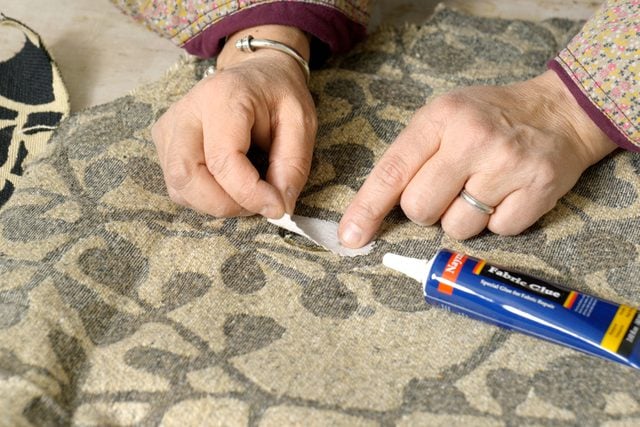
Add another fabric patch from the front (optional)
Turn the fabric right side up. If the fabric patch attached from the back is not flush with the rest of the fabric upholstery on the seat, cut another piece of the fabric about the size of your hole. Dab a small drop of glue in the hole and place the small piece of fabric in place. Use a toothpick to help you spread the glue evenly and guide the small fabric patch into place. Once again, be sure to orient the weave in the material so it is consistent with the rest of the upholstery. It is essential to get a good seal with the fabric glue.
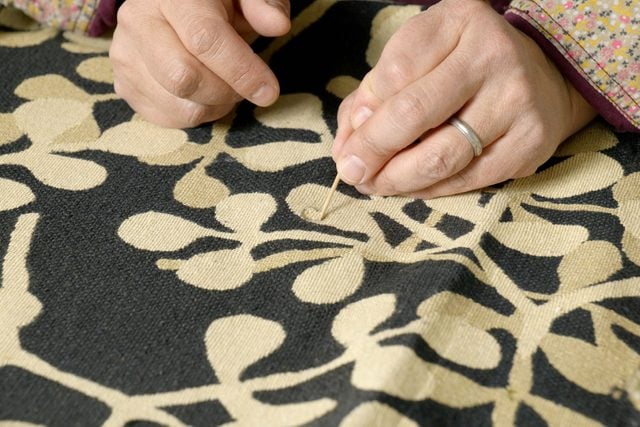
Reattach fabric to the seat
After finishing the upholstery repair it’s time to put the chair back together. I chose to change out the old foam and added new batting to give the chair a full, comfortable facelift. Reattach the fabric to the chair with an electric stapler and screw in using the original screws.
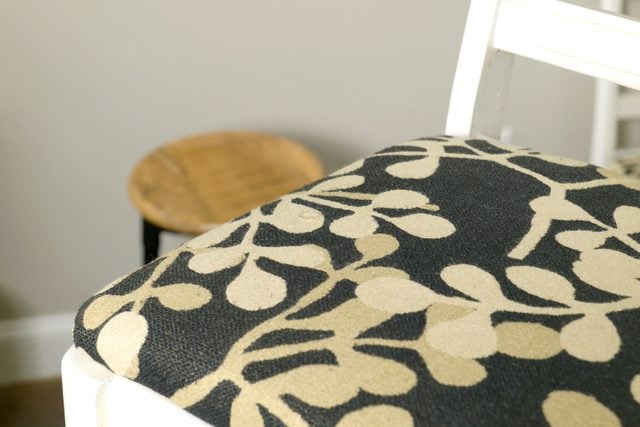
FAQs
Will any glue, such as “Super glue,” work for this repair?
No, super glue is not suitable for upholstery repairs. When doing anything with fabric or upholstery, there are two things you want in an adhesive: you want it to be flexible and washable. Most fabric adhesives are made with these two features and benefits in mind.
What types of fabric can I use any fabric to repair upholstery holes?
The first choice is to use the exact same fabric, so your repair isn’t as visible, but if you don’t have matching fabric, embrace the repair and make it an artistic choice. You can use fabric of a complimentary color. You can use iron-on patches; I have even seen people use old doilies to cover their holes and make a new statement. There are no hard and fast rules regarding fabric choices. Make your decision and go with it.
Does the weave in upholstery fabric make a difference when repairing a hole?
Yes, the weave in a fabric will make a difference, especially if the fabric has a backing weave of a different color. This will make it visible in the hole and prevent the repair from disappearing or fading. Pick a solid fabric that doesn’t show the inner weave in your repair. This is a personal choice; the backing weave standing out may bother some people and not others. I wasn’t happy when I discovered this, but I had to accept it because it was inherent in the fabric I was repairing — other fabric was not exactly right in color and weave.

